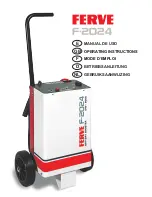
Have the vehicle towed to a qualified special-
ist workshop in order to have a deployed air
bag replaced.
It is important for your safety and that of any
passengers to have deployed air bags replaced
and to have any malfunctioning air bags
repaired. This will help to make sure the air bags
continue to perform their protective function for
the vehicle occupants in the event of a crash.
G
WARNING
Pyrotechnic Emergency Tensioning Devices
that have been deployed are no longer opera-
tional and are unable to perform their inten-
ded protective function. This poses an
increased risk of injury or even fatal injury.
Therefore, have pyrotechnic Emergency Ten-
sioning Devices which have been triggered
immediately replaced at a qualified specialist
workshop.
If the Emergency Tensioning Devices or air bags
are deployed, you will hear a bang and a small
amount of powder may also be released. The
6
restraint system warning lamp will light up.
Only in rare cases will the bang affect your hear-
ing. The powder released is generally not haz-
ardous to health, it could however cause short-
term breathing difficulties in people with asthma
or other respiratory problems. If it is safe to do
so, you should leave the vehicle immediately or
open a window in order to prevent breathing
difficulties.
Air bags and pyrotechnic Emergency Tensioning
Devices (ETDs) contain perchlorate material,
which may require special handling and regard
for the environment. Check with your local gov-
ernment’s disposal guidelines. California resi-
dents, see www.dtsc.ca.gov/
HazardousWaste/Perchlorate/index.cfm.
Method of operation
During the first stage of a collision, the restraint
system control unit evaluates important physi-
cal data relating to vehicle deceleration or accel-
eration, such as:
R
Duration
R
Direction
R
Intensity
Based on the evaluation of this data, the
restraint system control unit triggers the Emer-
gency Tensioning Devices in the event of a fron-
tal or rear-end collision.
An Emergency Tensioning Device can only be
triggered if:
R
the ignition is switched on
R
the components of the restraint system are
operational. You can find further information
under "Restraint system warning lamp"
(
Y
page 44)
R
the belt tongue is inserted into the buckle on
the respective front seat
If the restraint system control unit detects a high
accident severity, additional components of the
restraint system are deployed independently of
one another in certain frontal collision situa-
tions:
R
Front air bags
R
Window curtain air bag, if the system deter-
mines that it can offer additional protection to
that provided by the seat belt
Depending on the person occupying the front-
passenger seat, the front-passenger air bag is
activated or deactivated. The front-passenger
front air bag can only be deployed in an accident
if the PASSENGER AIR BAG OFF indicator lamp
is off. Observe the information on the
PASSENGER AIR BAG OFF indicator lamp
(
Y
page 45).
Your vehicle has dual-stage front air bags. Dur-
ing the first deployment stage, the front air bag
fills with propellant gas which reduces the risk of
injury. The second stage is then triggered within
milliseconds, filling the front air bag with the
maximum amount of propellant gas.
The deployment thresholds for the Emergency
Tensioning Devices and air bags are calculated
on the basis of the vehicle deceleration or accel-
eration occurring at various points in the vehi-
cle. This process is pre-emptive in nature. The
air bag must be deployed on time, at the start of
the collision.
The rate of vehicle deceleration or acceleration
and the direction of the force are essentially
determined by:
R
distribution of the force during the impact
R
collision angle
R
deformation characteristics of the vehicle
R
characteristics of the object with which the
vehicle has collided
56
Occupant safety
Safe
ty
















































